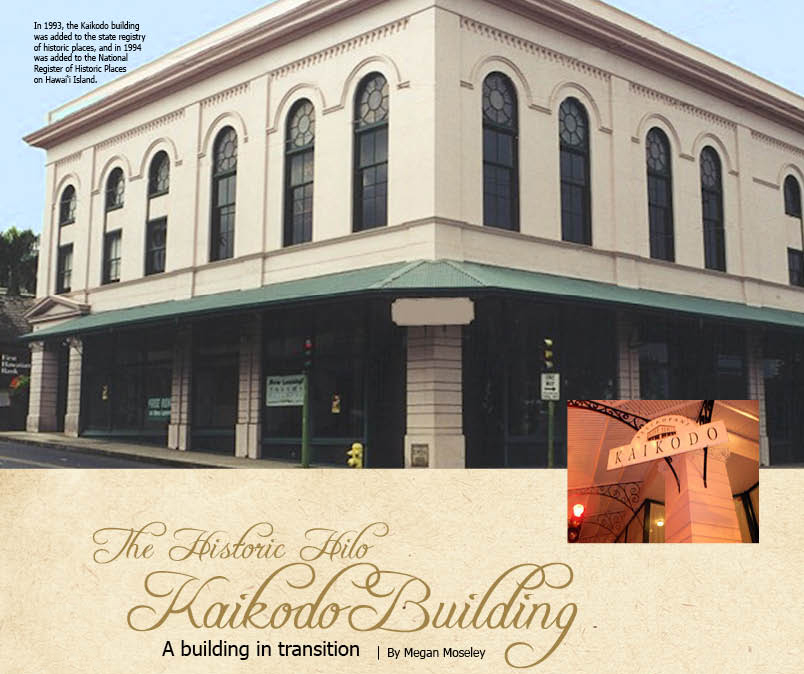
The Historic Hilo Kaikodo Building: A Building in Transition
By Megan Moseley
On the corner of Keawe and Waianuenue Streets in downtown Hilo stands the historic Hilo Masonic Lodge Hall built in 1908, currently known as the Kaikodo Building. From the outside, the structure may catch your eye for its concrete walls and towering windows.
If you were to take a closer look and stroll through the inside of the facility, make sure to take a breath as the beauty of the early 20th century facility may leave you speechless.
Replete with towering ceilings, spacious rooms, delicately crafted wooden staircases and a view of Hilo’s bayfront and downtown hub, this building’s aesthetic appeal is hard to beat.
About the Building
Located at 64 Keawe St., the Kaikodo Building, also formally referred to as the Bishop Trust Building, was built around the same time the Volcano Block Building and the S. Hata Buildings were constructed in downtown Hilo when Hawai‘i was still a territory.
This large edifice made a name for itself as being one of Hilo’s only concrete-constructed buildings. It has three floors, a basement, and was designed in a way to resemble the Renaissance Revival style.
It’s exceedingly spacious with stairways made of oak that lead to the upper floors. According to a newspaper clip dated January 18, 1906, the structure’s estimated original cost was $30,000.

On the second floor, there is a ceremonial temple room that was used by the Masons for gatherings. This one-of-a-kind meeting hall contains high ceilings (the room is about 35 feet by 55 feet) and has cast brass suspended light fixtures, along with an organ gallery. This room, in particular, is so incredibly spacious that it gives your mind room to think and inspires creativity. It’s also where the popular Hilo dance studio, Center Stage, used to reside before moving to its current location at the other end of town. While this area may have the “wow” factor, there are many rooms in the building that have been used for a variety of purposes.
One room, for instance, was the location for filming a dramatic scene for the 1987 crime thriller movie Black Widow. Multiple rooms have also been used as political campaign offices, hosted wedding parties, fashion shows, and more.
A partial third floor is also home to several offices, a former Ladies Lounge, the Organ Gallery, restrooms, a central light well, and several storage rooms, including an armory.
From the top of the structure is an incredible view of downtown Hilo. When standing on the roof, one can see the ocean over the breakwater in Hilo Bay, down Kinoole Street and Kilauea Avenue. You also have a beautiful view of a nearby arched Wainaku Bridge over the Wailuku River. According to older records, this area used to be used as a rooftop garden.
The Evolution of the Kaikodo Building
While the building is certainly alluring, there’s currently only one tenant left—Le Magic Pan, Hilo’s only French crepe restaurant.
Liza Belykh, a 23-year-old Le Magic Pan employee, says she’s always hearing customers comment on the building.
“They’re always saying how big and beautiful it is,” she says. “Of course they always try to check it out and go up the staircase.”
Next door to the French-inspired restaurant is where the Kaikodo Restaurant used to exist before closing down in 2007. The current owners, Howard and Mary Ann Rogers, opened that restaurant around the time when they first bought the space. However, that wasn’t their original intention.
“When we bought the building, although it was a wonderful and very special structure, it was tired and needed some attention to bring it back to life,” say the Rogers. “Our vision was to have a museum on the second floor, using the vast Masons’, what we called ‘ballroom,’ as the center of activity.”
With that idea in mind, they started making some additions and renovations, including adding a freight elevator, which ran from ground floor to the third floor in hopes of being able to transport the art they envisioned would occupy the upper floors in an almost gallery-like setting.
“We also reconstructed various room spaces to allow a more even flow of movement with the museum in mind. We then explored how we would have to do further renovations in order to satisfy the museums and private collections that we would be borrowing from for the agenda we had planned. We had actually gotten the archaeological team in Pompeii on board and had selected an exhibition of numerous treasures we would bring from that city destroyed by the eruption of Vesuvius to the foot of Mauna Kea—Pompeii to Pele! A brilliant idea!” the Rogers contest.
They also had plans to bring in an exhibition from Yokohama in Japan. Unfortunately, those plans fell through.
“After some testing and research, it became clear that the expense and time spent would not be met with the reception that we had hoped. So, that idea went, sadly, down the drain,” they explain.
So, instead of a museum, they decided to establish a restaurant, which required major renovations. The Rogers say, however, those renovations did not compromise the character of the landmark building.
“We removed some of the old walk-in vaults that were installed when the structure was used in part as a bank, and turned others into wine-cellars. We established a large restaurant area on the ground floor and laid new floors, installed an early 20th century, 20-foot wooden bar from England, a large set of tall wooden doors from a 19th century library on the Hainan island near Taiwan, their beautiful stained glass and carved wood setting off one section as a special Chinese dining room, with its deep red walls and ancestor portraits as décor.”
Another room was made into a sushi bar with large Japanese landscape-painted folding screens mounted on the walls. That area is currently where the Le Magic Pan is located.
While the restaurant may have closed a few years later, some of these beautiful details are still visible today, including light fixtures that are made of hand-blown glass from Murano near Venice.
“The restaurant saw some great days, got great publicity nationwide, but again, despite exciting activities year in and year out, it was not quite the right fit for Hilo,” say the Rogers.
Before the Rogers owned the building, it was purchased by Toyama Hawaii, Inc. in 1992, the same company that at one point owned Nani Mau Gardens. They are attributed with making some major renovations on the antique structure. In 1993, the building was added to the state registry of historic places, and in 1994 was added to the National Register of Historic Places on Hawai‘i Island. It is also included on Historic Hawaiʻi Foundationʻs list of properties.
Building a Brighter Future
The Kaikodo building has seen many walks of life come in and out of its doors. The Masons built the structure between 1908 and 1920 and left around 1985, when they decided to move to new premises. Since then, there’s been many people coming and going, yet nothing seems to last.
“What makes us most sad is that the building is not being used to its fullest potential,” say the Rogers. “It must sometimes feel abandoned and alone.”
Over the years, there have been various tenants that have occupied the structure including Bishop Bank, now known as First Hawaiian Bank, and Uncle Don’s Ohana Grill in 2009.
While the history of this Hilo staple may be written on its walls, its future is unknown and the current owners are hoping to bring new life to its doorstep.
“We hope that someone will bring life and activity back into it. It has great beauty and nobility and much potential. ❖
Contact writer Megan Moseley



